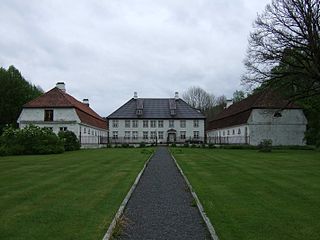
A blast furnace is a type of metallurgical furnace used for smelting to produce industrial metals, generally pig iron, but also others such as lead or copper. Blast refers to the combustion air being supplied above atmospheric pressure.

The Wealden iron industry was located in the Weald of south-eastern England. It was formerly an important industry, producing a large proportion of the bar iron made in England in the 16th century and most British cannon until about 1770. Ironmaking in the Weald used ironstone from various clay beds, and was fuelled by charcoal made from trees in the heavily wooded landscape. The industry in the Weald declined when ironmaking began to be fuelled by coke made from coal, which does not occur accessibly in the area.

A bloomery is a type of metallurgical furnace once used widely for smelting iron from its oxides. The bloomery was the earliest form of smelter capable of smelting iron. Bloomeries produce a porous mass of iron and slag called a bloom. The mix of slag and iron in the bloom, termed sponge iron, is usually consolidated and further forged into wrought iron. Blast furnaces, which produce pig iron, have largely superseded bloomeries.

The Lehigh Crane Iron Company, later renamed Crane Iron Company, was a major ironmaking firm in the Lehigh Valley from its founding in 1839 until its sale in 1899. It was based in Catasauqua, Pennsylvania, and was founded by Josiah White and Erskine Hazard, who financed its development through their Lehigh Coal & Navigation Company, which promoted the then-novel technique of smelting iron ore with anthracite coal. This was an important cost and energy savings technique, credited with eliminating the need for either expensive charcoal or coke producing processes and transport costs that proved central to the acceleration of the American industrial revolution.

The Tannehill Ironworks is the central feature of Tannehill Ironworks Historical State Park near the unincorporated town of McCalla in Tuscaloosa County, Alabama. Listed on the National Register of Historic Places as Tannehill Furnace, it was a major supplier of iron for Confederate ordnance. Remains of the old furnaces are located 12 miles (19 km) south of Bessemer off Interstate 59/Interstate 20 near the southern end of the Appalachian Mountains. The 2,063-acre (835 ha) park includes: the John Wesley Hall Grist Mill; the May Plantation Cotton Gin House; and the Iron & Steel Museum of Alabama.

Onota was a village in the Upper Peninsula of the U.S. state of Michigan. It was located on the Grand Island Bay of Lake Superior near the present-day community of Christmas about five miles (8 km) west of Munising in Alger County. The site of Onota is within the Bay Furnace Campground and Picnic Area of the Hiawatha National Forest. The remains of Bay Furnace, a blast furnace used for smelting iron, is the only extant remnant of the town. Bay Furnace was listed on the National Register of Historic Places and designated a Michigan State Historic Site in 1971.

The Katahdin Iron Works is a Maine state historic site located in the unorganized township of the same name. It is the site of an ironworks which operated from 1845 to 1890. In addition to the kilns of the ironworks, the community was served by a railroad and had a 100-room hotel. The site was listed on the National Register of Historic Places in 1969.
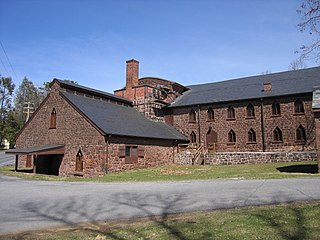
Cornwall Iron Furnace is a designated National Historic Landmark that is administered by the Pennsylvania Historical and Museum Commission in Cornwall, Lebanon County, Pennsylvania in the United States. The furnace was a leading Pennsylvania iron producer from 1742 until it was shut down in 1883. The furnaces, support buildings and surrounding community have been preserved as a historical site and museum, providing a glimpse into Lebanon County's industrial past. The site is the only intact charcoal-burning iron blast furnace in its original plantation in the western hemisphere. Established by Peter Grubb in 1742, Cornwall Furnace was operated during the Revolution by his sons Curtis and Peter Jr. who were major arms providers to George Washington. Robert Coleman acquired Cornwall Furnace after the Revolution and became Pennsylvania's first millionaire. Ownership of the furnace and its surroundings was transferred to the Commonwealth of Pennsylvania in 1932.

Dyfi Furnace is a restored mid 18th century charcoal fired blast furnace used for smelting iron ore. It has given its name to the adjoining hamlet of Furnace.

The Oregon Iron Company was an iron smelting company located in what is now Lake Oswego, Oregon. The company was established in 1865, and in 1867, became the first company west of the Rocky Mountains in the United States to smelt iron. The company failed after a few years, but was reorganized as the Oswego Iron Company in 1878, and again as the Oregon Iron and Steel Company in 1883. With the addition of a larger furnace, the last incarnation of the company prospered, reaching peak production in 1890. By 1894, however, pressure from cheaper imported iron combined with the effects of the Panic of 1893 forced the company to close its smelter. The company continued to operate a pipe foundry until 1928, and until the early 1960s, existed as a land management company, selling its real estate holdings which expanded the city of Lake Oswego.
The firm of Harrison Ainslie & Co. was a British firm of ironmasters and iron ore merchants, selling high quality haematite from their mines on Lindal Moor to smelters in Glasgow, Scotland, South Wales and the Midlands. From a 21st-century perspective, they are more interesting as the last operators of charcoal-fired blast furnaces in Great Britain. Their furnaces were stone-built, water-powered, and much smaller than the coke-fired furnaces of the same era.
The Grubb Family Iron Dynasty was a succession of iron manufacturing enterprises owned and operated by Grubb family members for more than 165 years. Collectively, they were Pennsylvania's leading iron manufacturer between 1840 and 1870.
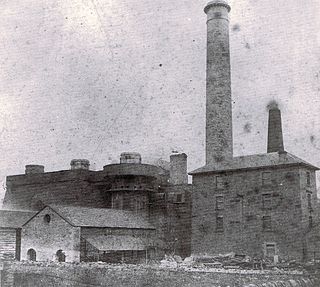
Parkend Ironworks, also known as Parkend Furnace, in the village of Parkend, in the Forest of Dean, Gloucestershire, England, was a coke-fired furnace built in 1799. Most of the works were demolished between 1890 and 1908, but the engine house survived and is arguably the best preserved example of its kind to be found in the United Kingdom.

Cinderford Ironworks, also known as Cinderford Furnace, was a coke-fired blast furnace, built in 1795, just west of Cinderford, in the Forest of Dean, Gloucestershire, England.
Embreeville is an unincorporated community and census-designated place in southern Washington County, Tennessee. It is located along the Nolichucky River and on State Routes 81 and 107.
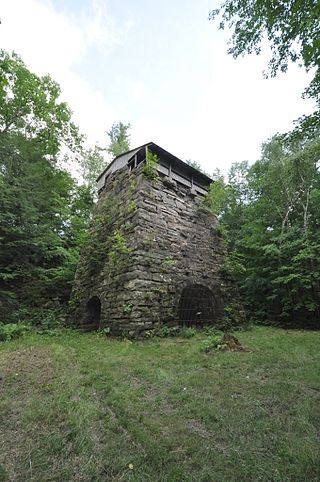
The Forest Dale Iron Furnace was a 19th-century iron smelting facility in Brandon, Vermont. Located off Vermont Route 73 east of the village of Forest Dale, it operated between 1810 and 1855, closing due to competition from higher quality and more efficient furnaces. Now reduced to archaeological ruins and the remains of its main furnace stack, it was listed on the National Register of Historic Places in 1974. The site is marked by a historic marker on Vermont 73.

The Bonawe Iron Furnace, was an industrial complex located in Bonawe, Lorn District, Scotland. It operated in the middle of the eighteenth century, with the aim of producing pig iron. Central to this complex was a charcoal fired blast furnace.

The Ilfracombe Iron Company (I.I.C.) was an iron mining and smelting company that operated in Northern Tasmania in 1873 and 1874.
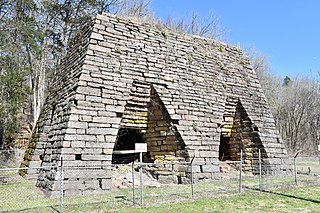
Cedar Grove Iron Furnace is a disused 19th century double-stack iron ore furnace located in Perry County, Tennessee. Sources differ on its construction date, but it was probably built between 1832 and 1834 near the mouth of Cedar Creek on the Tennessee River by William Dixon.














